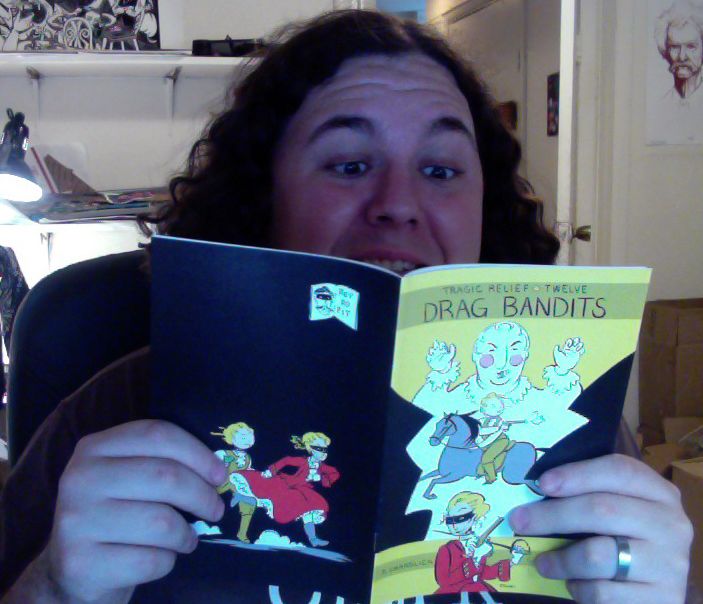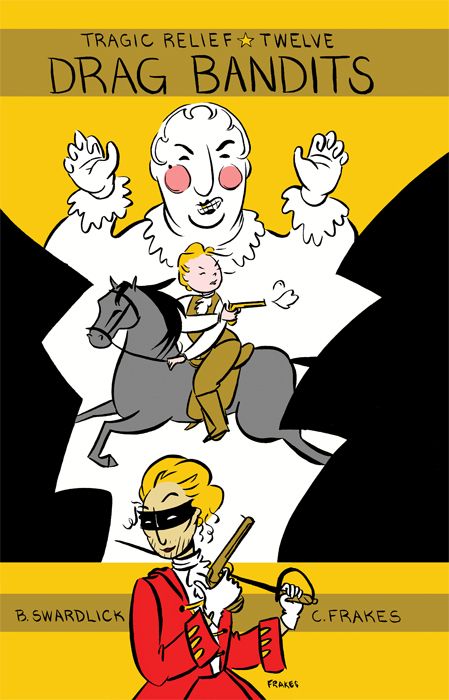While the rest of the world is going digital, Box Brown is heading in the other direction: Last month he launched Retrofit Comics with plans to publish 17 print comics by new and independent creators in the next 17 months. He got the seed money for Retrofit with a Kickstarter drive, and the launch comic was James Kochalka's Fungus. All the books are by different artists, and most are one-shots, although Brown said he is open to creators incorporating their Retrofit comics into their ongoing series. This month's release is Drag Bandits, by Colleen Frakes and Betsy Swardlick, which Brown describes as "kind of like The Scarlet Pimpernel, a woman dressed as a man and a man dressed as a woman, and it's really exciting." Comics by Pat Aulisio and Josh Bayer round out this year's offerings, and plans for the future include an anthology in the spirit of the Japanese underground-manga magazine Garo, a project that Brown says was the brainchild of Ian Harker, editor of the free alt-comic newspaper Secret Prison. The comics are sold both in selected retail stores and by subscription, and Brown estimates he has 150 subscribers to the four-month package and a handful with six-month or twelve-month subscriptions.
While he is handling all this, Brown, who recently won two Ignatz Awards, continues to self-publish his own work, and Blank Slate will publish his graphic novel The Survivalist in December. We talked to him this past weekend about the genesis of Retrofit Comics and what it's like to run a really, really small press.
Robot 6: Why did you decide you wanted to publish print comics, as opposed to going the digital route?
Box Brown: It wasn't really so much about print comics as much as it was about small format comics, shorter stories. It's more of a response to graphic novels than to digital. I have no problem putting Retrofit Comics on digital — I think they would probably sell well — but there are a bunch of different companies doing the digital download thing and none of them cater to me yet as a small publisher.
I love reading graphic novels, but it's difficult for new artists to all of a sudden produce a 200-page work. It takes a really long time to do that, and I don't think that is the best way to develop. For one thing, you are working in hiding, and you are not building an audience while you are working on a graphic novel, unless you are serializing it in some way, and also, when you finally finish it, you are still an unestablished artist and you are asking your readership to plunk down 10, 20 dollars for a work when they don't know what they are getting into — and you are asking a publisher to invest a lot of money in a work without being established. So I wanted to re-legitimize the short-format story, where an artist could work on smaller works, get them out faster, build an audience, and get some money while they are working on their bigger work.
If you go to a convention and go to see a young artist at work, they are all making minicomics, so it is still a viable format for artists. It's just because of the business landscape it has been difficult to get them to work. So I want to revitalize it a little.
Robot 6: How much of the prep work do the creators do, and what do you do in-house?
Box Brown: Some artists are better than others at getting their stuff print ready. James [Kochalka] just sent me finished pages, and I had to get them formatted for print, but with Colleen Frakes, who is probably much more accustomed to self publishing, all I had to do was forward them to the printer. So that's just an artist's quirk. But it's mostly just me in my studio dealing with everything — the printer, the subscribers, the post office, who has been the biggest headache out of anybody, and everything from A to Z.
Robot 6: How do you handle the problem of distribution?
Box Brown: I am trying to do it all myself so we can circumvent Diamond. For one thing, I don't think all these comics are appealing to all the people on Diamond's distribution list. I would rather print less of them and have them go to comics stores where the clients are interested in them than print a thousand extra copies that will sit on a shelf forever. And they are monthly, and soliciting for Diamond would be the worst thing ever. I would need so much lead time. As it is, I can have the artists get the comics to me a few weeks before release.
The shops are really cool. Everyone I have worked with has been really supportive.
Robot 6: So the comics shops tell you how many they want and you ship them?
Box Brown: Yes, and I invoice them. I distribute [my self-published work] through Microcosm and Tony Shenton, and through those guys I got to know the comic shop owners. We got like 10 shops before we even started the Kickstarter, and then once I launched the website and the Kickstarter, a couple more saw it and wanted to be involved. Sometimes if I see a good shop, I contact the owner, and they get back to me ... or they don't.
Robot 6: Do you think Retrofit will break even or possibly make a profit?
Box Brown: I would say that Fungus has broken even, if not made a little bit of a profit. The biggest expenditure in this whole thing I have found is shipping. Printing is actually really cheap, relatively.
Robot 6: You mentioned that the artists are being paid in books. What happens if Retrofit turns a profit?
Box Brown: It just goes back into the business. If it doesn't—I am doing enough work, I think it's compensation for that. When you are printing small runs of books — I have dealt with this before — [the publisher] keeps the majority of the books, you get 25 free ones, and when you go to a convention you have to buy the books from them, which is OK, you get them wholesale or less. But when you are dealing with royalties, every once in a while you get a really small check. Honestly, this is from a small press guy, I feel the quickest and best way for them to get the most money out of their book is to get a lot of free copies to sell at conventions and on their websites. That's the best way for them to get paid. I'm trying to keep it small basically so I can manage it.
Robot 6: How did you choose the artists who will be part of this? Were they people you already knew?
Box Brown: A lot of the people were people I knew from going to conventions; a few I just reached out to on the off chance they might be interested in working that way. Guys like Tom Hart and James Kochalka, who are established guys, I look to them for advice a lot anyway. I sent an e-mail to them to see if they thought it was possible, and James wrote back 10 minutes later saying "I'll d the first issue." People got really excited about it. I thought of this idea, I sent out an e-mail, and by the next day I had the start of the company without knowing all the pitfalls involved. I want to do it. I don't care. I want to do something epic. I believe in comics, I believe in the format, and I want to be involved in any way I could.
Robot 6: Are the majority of the comics selling through retailers?
Box Brown: I think so. We get a decent amount of orders every week. That was part of the point. I came up with this quandary a while back. I was walking from inner-city Philadelphia to my house in West Philly and looking for something to read at the comic shop. I couldn't get out of there with something I wanted for less than $20, but then, if I liked superhero comics, I could get three comics for less than $10. So I was like, this is not fair that they can go in every week and get a couple comics for a couple of bucks and have something to read on the bus, and I can't because it doesn't exist any more. I wanted to make it so you could go to the comic shop on a regular basis and get an alt comic. The retailers like that because they want people in the comic shop more often, not just coming in every few months when a Daniel Clowes book comes out.
Robot 6: So what's coming up after Fungus?
Box Brown: The second issue, Drag Bandits, by Colleen Frakes and Betsy Swardlick, will be going out early next week. Colleen has this really good, really controlled cartooning style — she's really good at simplifying things down to their basic elements, which is what cartooning is.
The next two issues after that are really art comics. They both have stories, they are both narrative, but they draw influence a lot from art comics. I was talking to Jessica Abel in baltimore right before SPX, and we were talking about this artist Josh Bayer whose book is coming out in December, and Jessica said, "You can tell right away that his art style is painterly. There's a large part that wants to be Gary Panter and there is an equally large part that wants to be Jack Kirby." I am excited about these guys. They probably have the smallest audience. Josh has been around for a while, he has been putting out comics and teaching comics, he works in New York and teaches comics full time, but I don't think he has ever had a major widespread release. His first comic, Bike Rider, got an honorable mention in the Best American Comics anthology.
The November release is Bowman, by Pat Aulisio. He has an art school background and he has been making comics since he was 13 — he's 25 now. He has a lot of kinetic energy, so I'm really excited about that too.
Robot 6: Why have you chosen not to publish your own work via Retrofit?
Box Brown: I kind of feel like it's a conflict of interest. The other thing is I'm looking to have other publishers publish my work anyway, and they can do that work. It's one less thing for me to do. I have a book coming out in December from Blank Slate books, Microcosm published Everything Dies 7. I'm working on a book about Andre the Giant, so I'm trying to find a publisher for that too.
Right now I have a big box of books, and I know the next few days will be the worst of the month. Shipping is the worst, packing and spending, you're just dripping postage, but once they are out it's not that bad. It's just a lot of organization, and sending e-mails.
Robot 6: Will you stop after publishing 17 comics?
Box Brown: I feel like if we get to 17 comics we might as well keep going. I would love it to continue, I would love it to be an outlet for emerging artists and undiscovered talent, as much as we can be. This is the first time I have ever really run a business that wasn't just my own stuff. I'm doing my best. It's volatile times, and it's difficult, and I'm hoping we stay afloat as best we can.



